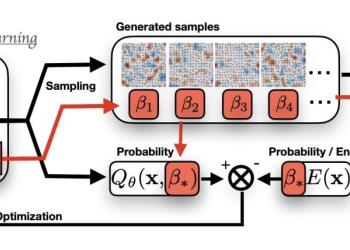
A groundbreaking study led by Professor PAN Ding and Dr. LI Shuo-Hui at the Hong Kong University of Science and Technology (HKUST) has introduced a novel direct sampling method utilizing deep generative models. This innovative approach significantly enhances the efficiency of sampling the Boltzmann distribution over a continuous temperature range, a breakthrough that could reshape the field of statistical mechanics. The research findings were recently published in Physical Review Letters.
The Boltzmann distribution plays a pivotal role in statistical mechanics, particularly for systems in thermal equilibrium. Accurate sampling from this distribution is essential for understanding complex phenomena such as phase transitions, chemical reactions, and biomolecular conformations. However, traditional methods like molecular dynamics (MD) and Markov chain Monte Carlo (MCMC) sampling often demand extensive simulation time, especially when high energy barriers are involved, resulting in substantial computational costs.
Revolutionary Approach with Deep Generative Models
Inspired by the latest advancements in deep generative models, Dr. Li and his team proposed the variational temperature-differentiable (VaTD) method. This framework is adaptable to any tractable density generative model, including autoregressive models and normalizing flows. VaTD facilitates learning the Boltzmann distribution across a continuous temperature spectrum, with thermodynamic quantities’ derivatives conveniently obtained via automatic differentiation, effectively approximating an analytical partition function.
“Under optimal conditions, the model theoretically guarantees an unbiased Boltzmann distribution,” explained Dr. Li. “More importantly, integrating over a continuous temperature range helps overcome energy barriers, thereby reducing bias in simulations.”
Unlike existing generative models in statistical mechanics, VaTD requires only the system’s potential energy and does not depend on pre-generated datasets from MD or Monte Carlo simulations. This independence marks a significant departure from traditional methodologies.
Validation and Potential Applications
The research team validated VaTD’s accuracy and efficiency through numerical experiments on classical statistical physics models, including the Ising model and the XY model. Prof. Pan highlighted the method’s potential, stating, “This breakthrough paves the way for studying novel phenomena in complex statistical systems, with potential applications in physics, chemistry, materials science, and life sciences.”
The study received support from the Hong Kong Research Grants Council, the Croucher Foundation, and the National Excellent Young Scientists Fund by the National Natural Science Foundation of China (NSFC). Part of the computational work was conducted on the “Tianhe-2” supercomputer at the National Supercomputer Center in Guangzhou.
Implications for the Future of Statistical Mechanics
This development represents a significant shift in how researchers can approach problems in statistical mechanics. By reducing the computational costs and time associated with traditional methods, scientists can explore more complex systems and phenomena that were previously too resource-intensive to study.
According to experts in the field, the VaTD method could lead to new insights and discoveries across various scientific disciplines. The ability to efficiently sample the Boltzmann distribution across a range of temperatures opens up possibilities for more detailed and accurate modeling of systems at the molecular and atomic levels.
“The potential applications of this method are vast,” noted an expert in computational physics. “From drug discovery to materials science, the ability to model complex systems with greater accuracy could lead to significant advancements.”
Looking Ahead
As the scientific community digests these findings, further research will likely focus on refining the VaTD method and exploring its applications across different fields. The success of this approach may also inspire new methodologies in statistical mechanics and beyond.
The collaboration between Prof. PAN Ding, Dr. LI Shuo-Hui, and their colleagues exemplifies the power of interdisciplinary research and the potential of combining physics, chemistry, and computational science to solve longstanding challenges. As this method gains traction, it could herald a new era in the study of complex systems, offering insights that were once thought unattainable.







